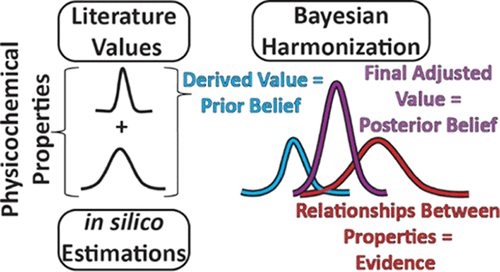当前位置:
X-MOL 学术
›
Environ. Sci. Technol.
›
论文详情
Our official English website, www.x-mol.net, welcomes your
feedback! (Note: you will need to create a separate account there.)
Novel Bayesian Method to Derive Final Adjusted Values of Physicochemical Properties: Application to 74 Compounds
Environmental Science & Technology ( IF 10.8 ) Pub Date : 2021-08-30 , DOI: 10.1021/acs.est.1c01418 Timothy F M Rodgers 1 , Joseph O Okeme 2 , J Mark Parnis 3 , Kyle Girdhari 4 , Terry F Bidleman 5 , Yuchao Wan 4 , Liisa M Jantunen 4, 6, 7 , Miriam L Diamond 1, 4, 6, 8
Environmental Science & Technology ( IF 10.8 ) Pub Date : 2021-08-30 , DOI: 10.1021/acs.est.1c01418 Timothy F M Rodgers 1 , Joseph O Okeme 2 , J Mark Parnis 3 , Kyle Girdhari 4 , Terry F Bidleman 5 , Yuchao Wan 4 , Liisa M Jantunen 4, 6, 7 , Miriam L Diamond 1, 4, 6, 8
Affiliation

|
Accurate values of physicochemical properties are essential for screening semivolatile organic compounds for human and environmental hazard and risk. In silico approaches for estimation are widely used, but the accuracy of these and measured values can be difficult to ascertain. Final adjusted values (FAVs) harmonize literature-reported measurements to ensure consistency and minimize uncertainty. We propose a workflow, including a novel Bayesian approach, for estimating FAVs that combines measurements using direct and indirect methods and in silico values. The workflow was applied to 74 compounds across nine classes to generate recommended FAVs (FAVRs). Estimates generated by in silico methods (OPERA, COSMOtherm, EPI Suite, SPARC, and polyparameter linear free energy relationships (pp-LFER) models) differed by orders of magnitude for some properties and compounds and performed systematically worse for larger, more polar compounds. COSMOtherm and OPERA generally performed well with low bias although no single in silico method performed best across all compound classes and properties. Indirect measurement methods produced highly accurate and precise estimates compared with direct measurement methods. Our Bayesian method harmonized measured and in silico estimated physicochemical properties without introducing observable biases. We thus recommend use of the FAVRs presented here and that the proposed Bayesian workflow be used to generate FAVRs for SVOCs beyond those in this study.
中文翻译:

推导理化性质最终调整值的新型贝叶斯方法:应用于 74 种化合物
物理化学特性的准确值对于筛选半挥发性有机化合物对人类和环境的危害和风险至关重要。计算机估计方法被广泛使用,但这些方法和测量值的准确性可能难以确定。最终调整值 (FAV) 协调文献报告的测量值,以确保一致性并最大限度地减少不确定性。我们提出了一种工作流,包括一种新颖的贝叶斯方法,用于估计 FAV,该工作流结合使用直接和间接方法以及计算机值的测量值。该工作流程应用于九个类别的 74 种化合物,以生成推荐的 FAV (FAV R )。由计算机生成的估计方法(OPERA、COSMOtherm、EPI Suite、SPARC 和多参数线性自由能关系 (pp-LFER) 模型)在某些性质和化合物上存在数量级差异,并且对于更大、极性更强的化合物表现更差。COSMOtherm 和 OPERA 通常在低偏差的情况下表现良好,尽管没有一种在所有化合物类别和属性中表现最佳的计算机模拟方法。与直接测量方法相比,间接测量方法产生了高度准确和精确的估计。我们的贝叶斯方法在不引入可观察偏差的情况下协调测量和计算机估计的物理化学特性。因此,我们建议使用此处介绍的 FAV R,并且建议使用贝叶斯工作流程来生成 FAV超出本研究范围的 SVOC 的R s。
更新日期:2021-09-21
中文翻译:

推导理化性质最终调整值的新型贝叶斯方法:应用于 74 种化合物
物理化学特性的准确值对于筛选半挥发性有机化合物对人类和环境的危害和风险至关重要。计算机估计方法被广泛使用,但这些方法和测量值的准确性可能难以确定。最终调整值 (FAV) 协调文献报告的测量值,以确保一致性并最大限度地减少不确定性。我们提出了一种工作流,包括一种新颖的贝叶斯方法,用于估计 FAV,该工作流结合使用直接和间接方法以及计算机值的测量值。该工作流程应用于九个类别的 74 种化合物,以生成推荐的 FAV (FAV R )。由计算机生成的估计方法(OPERA、COSMOtherm、EPI Suite、SPARC 和多参数线性自由能关系 (pp-LFER) 模型)在某些性质和化合物上存在数量级差异,并且对于更大、极性更强的化合物表现更差。COSMOtherm 和 OPERA 通常在低偏差的情况下表现良好,尽管没有一种在所有化合物类别和属性中表现最佳的计算机模拟方法。与直接测量方法相比,间接测量方法产生了高度准确和精确的估计。我们的贝叶斯方法在不引入可观察偏差的情况下协调测量和计算机估计的物理化学特性。因此,我们建议使用此处介绍的 FAV R,并且建议使用贝叶斯工作流程来生成 FAV超出本研究范围的 SVOC 的R s。











































 京公网安备 11010802027423号
京公网安备 11010802027423号